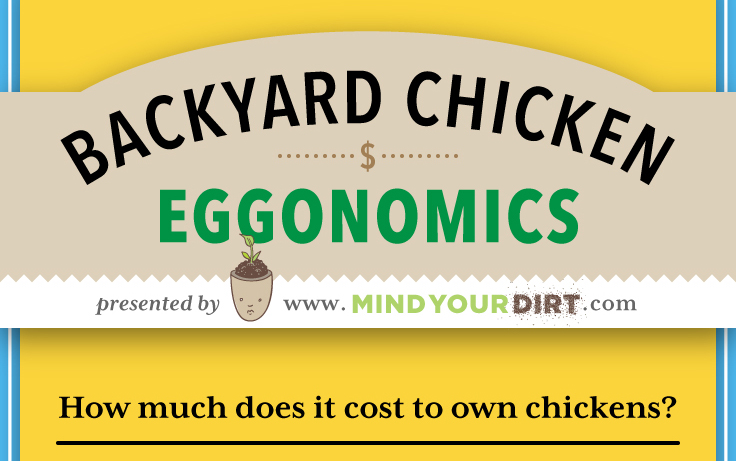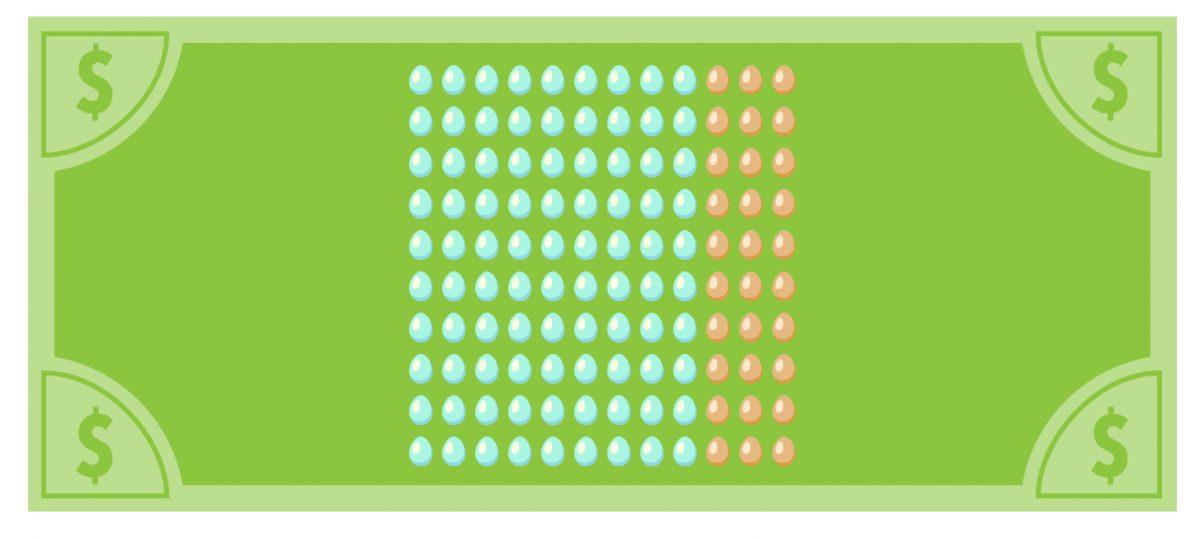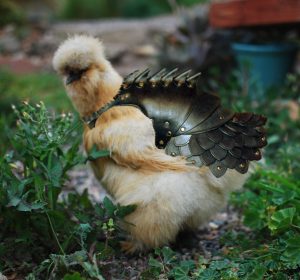I’ve found that this is a question I’m often asked when I tell people that I raise backyard chickens. How much does it cost in dollars as well as time? So I decided to start taking notes of all my expenditure, the time that I spend on tending my flock as well as what I’m getting out of having backyard chickens. I always figured I kinda broke even, but I was surprised to discover that I actual turn a handsome profit for my labor of love.
I’m not even taking into account the pure entertainment value of these mini dinosaurs running all over my yard acting less than intelligent. I’m simply talkin about cold hard cash money that I’m either saving by not having to buy the byproducts or from selling the surplus eggs I get weekly. Glorious, beautiful organic eggs. You can’t beat the flavor, but even more so, you can’t beat the knowledge of knowing exactly where your food is coming from and what’s in it. Or not in it for that matter. No chemicals, no hormones and no general malaise from chicken depression. Happy animals make for tasty food stuffs! And just look at these beauties!

But the benefits don’t stop there! Let’s break down a typical month over here at the Mind Your Dirt “farms” during normal production times.
I currently have four lovely hens in my flock. Some more prolific than others. Some more entertaining than others. I currently have my two powerhouses, a Rhode Island Red and an Ameraucana or Easter Egger. They lay the large and yummy eggs and do so almost daily and almost all year round in my climate. I also have a Blue Polish which lays medium sized white eggs and my famous silkie named Piper, who lays smaller tan eggs. You can learn all about the breeds and these specific hens here. There are some cute videos of them as little baby chicks that may just melt your heart. Viewer be warned.
The two main monthly expenses (barring any illness or acts of god etc.) for my set up is food and straw.
Feeding chickens can be a breeze as well. In addition to your layers pellets and a small amount of scratch, you can add almost all of your kitchen scraps to their diet. That means nothing goes to waste and the landfills won’t get over-loaded with your garbage. The only bin I put out to the curb is my blue recycling bins. I hardly produce any actual garbage between my worm bins, compost bins and chickens. Supplementing their diet with table scraps really stretches out your chicken feed budget significantly. If you allow them to free range in your yard, they’ll also eat all your weeds and garden pests! That means no need for pesticides or harmful chemicals at all! It’s a win win…win win. On average, I use about 25 pounds of feed every month, totaling roughly $10.
The straw is used for bedding material in the chicken run. It helps keep smells down by absorbing all that poop and gives the chickens some fun exercise while the scratch away all day long searching for bugs and yummy treats. There are many options for coop and run materials, I prefer straw for one main reason. Compost! Straw is an excellent carbon addition to the ratio of carbon:nitrogen in your compost bin. Curious about composting? Here’s an excellent place to start!
On a typical month, I’ll conservatively use one full bale of straw. Usually much less when I tend to get a bit lazy. Well, not lazy exactly, Because I’m writing blog posts just for you. Let’s say I’m in a hyper productive mode for this scenario. One bale of hay is about $10 per month.
If straw is too hard to come by in your area, or you simply want some alternatives, here’s a good place to start. I can only vouch for straw however as that’s all I’ve used. For some more in depth reading on proper substrates and their pros and cons, as well as ANY chicken related questions you may have, go to Backyard Chickens website. Such an excellent resource and a stellar community of enthusiasts and experts! Other than Mind Your Dirt of course…
So, that broadly sums up the monthly expenses. I’m averaging about $20 total every month on these chicken raising needs. But what about the benefits?
We’ve already touched on eggs a bit above, but let’s get some more details. On an average month my hens will produce about 90-120 eggs. Grant it, this is only for the first few years and they will taper off and eventually stop production. It’s up to you and your conscience as to what happens next. I’m not emotionally ready to give instructions on butchering your girls, maybe in a few years. But until that fateful day, the hens will produce like crazy! I’ve noticed that my most prolific hen is the Rhode Island Red. Not much on the personality, but an ace when it comes to the weekend scrambles. What hens do you recommend as egg layers?
Currently in California, organic eggs will go for around $6 per dozen. Sometimes higher. They often claim to be free-range, but sadly that is not always what you think it is. The cost of eggs in California has recently increased due to some legislation, that I supported, that allows for some more humane treatment of livestock. For more information on that hot topic, go here.
My hens only get organic feed, pesticide and chemical free weeds and vegetables, table scraps made by yours truly and free bugs in the yard, that are also relatively free of any chemicals. They are at least once they enter the Mind Your Dirt Official Wildlife Habitat. What they get into before entering my sanctuary is out of my control. For now at least. My girls are outside ranging from sunup to sundown, every day. The look and act like the happiest healthiest chickens you’ve ever seen or imagined.
That’s what goes into my eggs. And that’s exactly what you taste when you eat them. Love and health. Now I can’t eat eggs 24/7, no matter how hard I try. Therefore, I tend to have a surplus. I give many to neighbors out of respect and general neighborly coolness. The others I sell to friends and family at about fifty cents per. That’s a fair price for eating only the eggs of hens you personally know by name!
That said, I’m looking at around $45-$60 of eggs for either myself or for friends and family. No small chump change huh?
Now lets talk about poop! Finally right? The average chicken will generously donate about four pounds of poop every month! That’s a lot of crap! But that poop is so rich in nitrogen that it’s like black gold for your garden! It’s so nitrogen rich in fact that you have to mature it a bit before adding it to the soil or else it will burn the roots. You can mature it in your compost bin or simply leave it in a pile with some leaves or straw from the coop and run. At least a few months. I simply rake up all the straw and poop and add it directly to my compost bin.
My girls produce roughly 16 pounds of manure every month. At the store, 16 pounds of matured chicken manure will cost you roughly $6. You can see the money adding up!
Composting is such an amazing way to get nutrient rich organic material into your garden or flower beds. It also serves to not add this precious material to the landfills where all those nutrients will be wasted. Once again, here is an excellent place to begin at little to no cost to you! Read that article for more in depth discussion of the huge advantages as well as simple ingredient lists and time saving tips.
When you combine the carbon rich straw with the nitrogen rich chicken manure, it’s the perfect ratio to breakdown fast. in short, no math! Huzzah to no math! You simply rake it up from the run or coop and add it to the pile. Bam! Simple and effective. Remember, it’s always best to let the manure mature for a few months before adding it to the garden!
I estimated that I get around 3 cubic feet of finished compost from raising backyard chickens. At the store, that’s about $10 worth. And that’s not including the added fertilizer that the manure provides! Once again, you see the profits adding up!
If you tally all that up, you’re looking at a maximum profit of $41-$56 per month! That’s only for four chickens, imagine if you had six or more! They take up so little room and are relatively easy to care for when you take into account how much they provide. Even if you have no use for the manure and compost, you can still make $25-$40 from the eggs alone. Or sell their poop to someone who goes in for that type of transaction.
Curious as to where to get started? Try to determine what type of coop and run you’d like to have in your space. It’s a great way to save some money as well as make it personal to you and a perfect fit for your particular yard space! You can get really creative too or re-purpose a structure that’s already in your yard. If you’d like to see how I built mine, then check out this in-depth article with crazy futuristic 3D video walkthroughs. From the future.
I absolutely adore mine and it really cut down on maintenance having a loft style and gravity feed water system. I typically spend about 45 seconds a day in maintenance! And half that time is gathering eggs. Also, having it up on stilts really helps keep predators and rats away. In fact, I’ve had zero signs of rats at all. I’ve also NEVER noticed any bad smells in the slightest from this design. Poo for thought.

Take a gander on my main page for links to more articles about the fun of raising chickens! I never thought that I would enjoy it so much and get so much out of it. I adore my girls, especially little Piper. By the way, here’s some shameless Piper promotional shots.
That little fuzzball is ridiculously cute and sweet. Not the biggest egg producer due to her size, but again, the entertainment factor with this one is through the roof! She also adores her papa and comes running whenever I call. Watching this fuzzball in a full run into your outstretched arms is sight you must behold. Adorable does not do it justice. Sometimes, she’s so eager that she forgets to stop once she’s reached me and bounces off of my legs. Heart. Melt.
I’m so glad that raising your own chickens is becoming a trend again. Not to long ago, everyone who had a yard, even crazy city folk, had a small flock to feed their family. Raising baby chickens is something that every child in the world can get into and it’s such a great way to teach young children responsibility and caring for small animals. During WWI, it was actually your duty as an American to tend the flock.
So what are you waiting for? Isn’t it time to return to self-sufficiency and healthy lifestyle choices? I’d say it’s high time for a return to doing what makes us human and get better connected to where our food comes from. I’m here to help get you started and I’ll be here to help along the way as well.




















James I’m absolutely speechless what an inspiration to anyone looking to make an impression on Mother Earth
Thank you warmly Richard! Perhaps you can send this on to your daughter. Wasn’t she interested in starting a coop?
Oh, James, this is a wonderfully informatiive article! … LOVE your infographic. I just picked up Inkscape to do my permaculture design, and I’m hoping it will be good for this kind of thing… Not so intelligent “mini-dinosaurs” is the funniest and most APT descriptions of chickens I have ever heard… Where on earth do you get organic feed for $10/25 lb? $25/40 lb is the best I’ve been able to do… We’ve had Barred Rocks who laid as prolifically as the Reds; Buffs and Marans somewhat less. Around here, Red Stars are rumored to be the best layers… Considering putting our portable coops on stilts – builtin shade as well as protection. Thanks for another good one!
Thanks a billion Aggie! I’ve not heard of inkscape but it sounds like a fun program to learn! I’ve been using Google Sketchup, which you can get for free. I did the entire coop build in that. You can open doors and test hinges with it, and it saved me so much money and wood! Plus, the walk through virtual tours is so cool.
It’s true, watching chickens is like being in the movie Jurassic Park, except you’re way larger than the biggest T Rex! So less fear.
I get my feed and straw at City Farmers Nursery over on Home Ave (very close to me). I buy a 50 lb. Bag for twenty bucks and it’s the same for a bale of straw. Their straw is pricey because we’re away from any rural locations, but the feed is cheaper than I’ve seen elsewhere.
I’ll look into Red Stars for my next batch of hens, thanks for the tip! And yes, the stilts make for easy clean up as well as added safety, I love it!
Thanks again Aggie, I’m so glad you enjoyed it!
Inkscape is only a vector drawing program, though. I sense that it doesn’t do much 3d.
Sweet feed deal! Nothing close in Texas.
You realize the Red Stars will have no personality, right?
Thanks again.
That’s where Piper comes in! Silkies are ALL personality! I’m more curious about the working hens!
Great post, but I think your numbers are way off! I have 12 hens and don’t spend $20 a month. We do buy layer feed-50# about every three months or so. Cost at TSC :$15-$16. With 7 people in our household, we have a lot off table scraps and also grow leafy greens/herbs in a garden specifically for chickens to eat. I buy bales of straw and hay from a local amish farmer, Usual 12 bales at a time, cost: $5 bale. I don’t go through a bale a month for the chickens, but I also have rabbits which use it. I also get wood chips free from a friend that owns a tree service. The wood chips are very small and mixed with grass leaves etc. This makes a great bedding in the run and always comes with lots of little bugs for the girls enjoyment. I would think my total cost is between $10-$15 a month for 12 hens.
I have a variety of hens: production red, Buff Orpington,, Easter Eggers, leghorns. With an average lay of 1 per day/per hen, I would get close to a dozen eggs a day/7 doz wk, but realistically, it is closer to 6 dozen eggs a week. Other than the production reds, which lay daily, the rest lay an egg about every 24-30 hours. Above what we use, we give some away and sell some. We have enough who buy that actually more than offsets the cost of the feed etc. The average person with a backyard flock of 4-6 hens can easily make those hens cost neutral with a small herb/vegetable garden.
Thanks for all the information and the great graphics.
Yes, I was rather conservative with how much it actually costs me in supplies. As I mentioned in the article, I don’t always go through a lot of straw so the costs are often cheaper.
Here’s the big difference, you can see the San Diego downtown skyline from my yard. I live in the city and supplies are not as accessible to city folk.
Which is why I wrote this, so people outside of typical farming areas can explore a more agricultural lifestyle. To empower urban people to adopt a mentality that rural people already know about. My friends in the country almost all have experience raising chickens. It all around them. People like me that have always tread the cement and steel paths are the ones I want to inspire.
So supplies are a bit more difficult to come by. Table scraps also, you have seven people, I only have me. I also eat like a bird and sometimes skip meals so my scraps don’t add too much to the flocks diet.
The numbers are always going to vary, the main point to get across is how easy it is to have chickens pay for themselves and to inspire people to give it a shot and learn how rewarding it is!
Thanks for sharing the link and for your awesomeness in general!
Reblogged this on Save Green Going Green.
Reblogged this on Blisters, Bunions and Blarney and commented:
I haven’t got as far as the funding of our future project although I know there will be a point I’ll need to do the sums. So nuggets like this article are like gold to me. Wonderful post. I like the side benefits other than the overall monetary profit to be gained from the endeavour, particularly the value of chickens to soil and their role within a permaculture project more generally. Every element in the land should have more than one function – this is a great illustration of that design principle.
Thank you very much! It’s true the money aspect does little for me compared to what chickens provide for my belly and my soil.
It’s a whole symbiotic system that is now established that I adore most. Nothing goes to waste and so many materials are provided.
I meant what I said about not producing any garbage. There seems to be a use for everything now. And once that methodology sinks in, it becomes addictive. If there’s a week that I have to put the black garbage bin to the curb, I feel that I have failed in some way and must redouble my efforts to produce less waste. It’s kinda fun and super inspiring!
Again, thank you for reblogging and I hope you stay in touch!
What brilliant information James, I know that I don’t live in the States and the calculations would be slightly different here, but your writing has inspired me to look again at having some chickens in our small garden. I do love them, and eggs so it would make every bit of sense to keep them. I’ve reposted on Pinterest.
Thank you kindly Agnes, I’m so glad you like it! They are definitely worth the effort. Yesterday I came home from work and noticed a whole snail party going on in one of my beds. I opened the gate to the run and directed the chickens to join this unwelcome party. It was a clockwork carnage. They cleaned every pest off of my plants in seconds. It’s like having a well trained group of mini velociraptors that take care of business. “release the girls!” I murmured.
Send the girls over here please James 🙂
James I only just heard chickens are related to T Rexs – mini dinasours indeed. I just love chicken keeping posts – I live vicariously through them until we get girls of our own. Your chicken photos are pure delight – in prticular your gladiator chicken attire. Thank you James!
Poor T. Rex. How the mighty have fallen. I did end up building Piper some armor. Samurai chicken! I then discovered that they actually make saddles that do the same job. The armor built up her confidence and the other girls don’t know what to make of her so they’ve backed off a bit. Happy days!
Ohhhh you are a good chicken Dad! I reckon there is an untapped market in chicken cute attire – if you are looking to start a new business. 😁
Business wear is next. And maybe a tux and top hat too. I definitely have too much free time…
Yes a tux and bow tie! Brilliant. I might sound facetious but I am actually serious – you have a potential winning business idea on your hands. It is unique and quirky!
To the sewing machine!
James, what an excellent article! You are so right aboit the financial benefit to raising your own and doing it naturally. And for those of us not afraid to get into using excess livestock as a food source, the benefits increase further. Sure, it’s a little hard to get your head around at first, but what a waste for all those cockerels to go to the kites and foxes. And at least I know what my chickens have eaten and how they have lived! Happy chickens = better food. Instant follower… mother hen
Great minds think alike! So glad to have you as a follower!!
I know I need to get over the culling aspect but I’m afraid I’ve bonded too closely with my four girls. Perhaps with the next batch. It’s hard for this city boy to break away from the “pet” mentality. I’m working on it because my current habits are nonsustainable. If I keep going this way I’ll have fifty hens in retirement and no eggs at all.
Baby steps.
Based of what I’ve read on your blog, I’m tickled pink that you like mine! Thanks again!
Thank you for the hih praise! And I completely understand “pet mentality”. My flock currently consists of 10 laying hens and my cockerel, plus 4 young pullets and two young roos, one of which is pure buff orp and may replace my current cockerel, but it will depend on how good he is to my girls. They work hard for their money and I’ve had male aggresson issues in the past. When I caught my last BO roo attacking a hen he had bullied and nearly plucked bald, my pet mentality died a swift death. He was plucked and in the stewpot before the sun set. 😨 Ever since then, my need to cull when necessary has got easier. When needs must, the devil dances…
I’ve also had a punk rooster who liked to beat up on ladies. He was a silkie so there was no way to properly sex him as a day old hatchling.
I’m on less thank half an acre so having roosters is illegal for me. That coupled with the spousal abuse left me only one avenue to pursue.
It was a shockingly awful experience for me. And this was a chicken that I had a lot of hatred for. I still get emotional thinking about that cold morning finality. *shivers*
By nature I am extremely nurturing and dealing death does not sit well with me. Even with lowly bugs. This feeling only intensified when I lost my father to the big ugly C back in 2010. I can safely say that I am actively trying to avoid death in all forms now. Hopefully this will pass with time in regards to “constructive” death dealing.
It’s amazing how emotional one can become after watching someone you love pass away. It changes you.
Now, before I bum everyone out, let me ask you this, were you raised in an environment like a farm or the 4H that would help bolster you for culling? I think I’ve suffered a loss for not learning these lessons early in life. They didn’t cover this in boy scouts.
Perhaps I need to take a class with a therapist on hand to help me along. City folk…oh boy.
Ah. I understand. Dealing the D card is never, ever easy. We get inured perhaps, but it is always a hard choice and a harder act. I had no 4H traiinf, but was raised on a farm in my early years, my grandparents nearly always lived rural, and my grandpa was a professional hunter. Still, citified me had to have my daughter (who also keeps hens) cull my first hen, And that was a mercy killing since she was so very ill. But getting rid of my enormous BO cockerel was putting the needs of the many ahead of the needs of one. He was a heavy bird and very hard work, but I managed it on my own, having done a lot of research about how best to carry it out. Swinging him by his feet until he passed out then cutting the jugular. He was gone In 60 seconds and unconscious. But it changes you for sure. Given my druthers, I would keep them all alive and eating me out of house and home. I’m truly a softy at heart.
Love the post and the info-graphic!!!
Thanks Doc! Although, my girlfriend deserves all the credit for the info-graphic. I just made a poorly drawn sketch and then she worked her magic! Under my direct supervision of course 😉
Cheers!
I’m desperate to raise chickens. Even have the perfect enclosure! My husband says he is not a chicken rancher. No chickens! One of these days I will have chickens!
Maybe he can become a passive chicken enthusiast via your small flock! Just start buying super expensive eggs and leaving the receipt laying around. That should do it!
James–a very belated thank you for the follow! We lost a dear flock member last month & it took me some time to get back into the spirit of blogging. Just love your drawings! Wonderfully factual & funny!!! I wish I could say that duck economics work out the same (or maybe it’s just me–it’s probably just me) but can anyone put a price on love? We get so much enjoyment out of our waterfowl, having them around is worth every penny (or Benjamin.) The pest control & fertilizer are bonuses and we’re happy to have ’em but we’re really in it for the cute. 🙂 Thanks for the great post!!!
HI James,
Dirty thoughts makes things grow? Too funny! No wonder you have such an engaged community.
You dropped by my site today, and I wanted to come by to say thank you. I am glad you liked my post about how to write hooks in your introductions.
Janice
Thanks Janice! I love my readers they have shown me a world of like-minded homies for life. My peeps rock.
Excellent information! I’ve got a question about straw bedding – what are the dimensions of the bales you use? Here abouts in rural Ontario I’m coming across several sizes of bales (and also straw types). So in order to calculate how many is a reasonable number to order for a season, it’d be really useful to know how big yours are to get a ballpark figure. Many thanks!
Thanks so much for stopping by! Roughly, the bales are about 4 feet long by 2.5 feet. I can say with certainty that the are very heavy if that helps at all. I’ve not seen other sizes before, otherwise I would’ve been more specific. Are you just starting out with chickens? Of so, I’m so happy to hear! Let me know please. I’m here to help in any way.
Ahhh, thank you! The bales I have to choose from are 3ft x 3ft x 7ft (and 8ft). I am indeed just getting into chickens and finding super basic information like – ‘how much bedding does one typically go through in a year?’ amazing difficult to find. I’ve read Gail Damerow’s ‘Raising Chickens’ about 3 times now but even that detailed tome doesn’t tell me…I’ve got 2 dozen eggs in an incubator (chick prices are prohibitively insane here if you want heritage breeds) and am very excited about the prospect of having a flock on our 1.3 acres.
Your other information is grand and I’m lucky that we have enough space to pasture and enough interesting/diverse places to forage (we’ve got ~12 ancient apple trees) and offsett feed costs.
Thanks again 🙂
Sounds like a perfect environment for a flock! You might even have the space to do the double run coop, which I’ve always wanted to make.
That’s when you have a run on both sides of the coop (left and right) and alternate between the chickens and a garden every year. My dream scenario.
As for bedding, a lot depends on how much rainfall you get as well. Straw will break down faster with rain and especially snow. Not a real problem where I am in San Diego.
How thick of a layer will change you figures as well. I like a nice 4-6 inches at minimum to keep any smells at bay and also give the girls something to scratch and dig in.
Since writing this, I’ve also added homegrown greens into the mix. Kale and cabbage for example. The dark greens really bring out the good orange yolks. But if they can forage freely, you shouldn’t have to add these. I just have a small urban lot, so I like to up the nutrients manually.
Sounds like you are on the right path and doing your research! Post any photos you like on Mind Your Dirt’s Facebook page please! Sharing is caring and I’d love to see your progress!
Yours,
James
I have three very spoiled hens. They consume the quantities of food that you mention, but I only get about 12 or 24 eggs a month. The girls have a hug covered yard with their own compost pile and plenty bugs to catch. Any suggestions?
That does seem rather low indeed. However, some breeds simply lay less than others. Just as some breeds are better as meat birds.
What breed of chicken do you have?
I’ve had another thought while eating lunch. How old are your hens? They ha e a finite number of eggs and another explanation could be that they’re reaching the end of their egg laying careers.
I have one golden commet and two americana’s. I think they are about three years old. These birds are pets, so they will not be meeting a stew pot. I did notice that one hen’s eggs were breaking and the shells were very thin. I added a Tums to their drinking water.
Both breeds are not the worse layers out there. My americauna does fairly well and lays about 5 a week. They are also around that age.
Which makes me think that nutrition may be the culprit. I assume that you are feeding them layers pellets and not meat pellets right?
Crushed oyster shells are a possible and natural way to introduce calcium for stronger shells. However, I’ve heard tales of possible contaminants like mercury. Most likely not in high enough levels to do any harm.
I’d avoid tums for both cost reasons as well as all the other chemicals that are in them. Sucrose, Calcium Carbonate, Corn Starch, Talc, Mineral Oil, Natural & Artificial Flavors, Adipic Acid, Sodium Polyphosphate, Red 40 Lake, Yellow 6 Lake, FD&C Yellow 5 Lake (Tartrazine), Blue 1 Lake.
You wouldn’t eat tums everyday for your whole life I hope. So neither should your hens.
A good and known safe method to increase calcium is by crushing their eggshells and feeding them back to the hens.
What’s the brand of feed that you use?
My hens will also not be meeting the stew pot. It’s full on retirement once they’ve stopped laying. They can still provide manure and entertainment anyways.
My hens have laying pellets 24/7 along with oyster shells. My roommate also gives them bird seeds and oatmeal. They also have full access to the compost pile where both table scraps and yard wastes get put. They constantly scratch through it looking for bugs and seeds. They really love the Japanese green beetle larvae. The better layers, if you will, are also good mousers. I put egg shells into the compost pile. My Golden comet, Apricot, eats her shells. She is also the best layer. The other two don’t. The birds refused to drink water with Tums and we replaced it with fresh water.
Well it sounds to me that the girls are getting everything they need. I’m at a loss as to what the cause would be!
Perhaps eating a bucket of KFC in the run would get the message across. Or placing a big chopping block nearby with a well sharpened axe in it. Get inside their heads!
Let me do a little research and see if I can’t narrow this down…
Here’s another link to check on… http://www.backyardchickens.com/t/1089099/not-laying-yet-even-though-its-spring#post_16717552
One question I didn’t think to ask is stress related issues. A new flock member, a change in their housing or a predator can cause chickens to stop laying.
Is there anything that could be causing them stress? Maybe even at night when your asleep? Like a racoon coming by or the like.
I can look into the protein issue. I’ll add lentils and beans (sprouted or ground up) to their diet. Maybe that could help. Just got the new girls this afternoon. Lot of swearing going on. Coopers Hawk buzzed us to check out the commotion. I think I might modify their home to provide more cover. They have a yard with a ceiling of chain link. I planted vines around it and a tree in it. All need to grow. They spend the night in a wire kennel that has a tin roof. They are safe, but a sniffing predator could unnerve them. Perhaps an adobe hut would help. I have lots of really good adobe soil. I could build one inside their yard. I am taking beginning wood shop. Still on the first project – cutting board. I need to learn a little more before making them something akin to what your silky has.
Every journey begins with that first step! Wood shop sounds fantastic, good for you. There’s nothing like a nice wood working project to sooth the soul. A very noble and meditative venture. My advice would be to always know the grain of your piece. Take the time to study it before anything else. I could go on, but then I’d turn into Ron Swanson. Again.
I’m beginning to feel as though that hawk of yours can be part of the problem. Chickens don’t miss a beat when it comes to overhead flight! My girls will eyeball nervously a high altitude airplane when I can barely see it.
Maybe you can manufacture what the vines and tree will eventually do with some sort of cover over a portion of the chain link fence? Something that won’t block too much light from your tree of course.
What manner of tree and vine have you planted? In San Diego, passion fruit and grape seem to grow the fastest. The latter also offering your chickens many treats as they love both the fruit and the leaf.
The adobe sounds really beautiful, but also sounds very hot. Ventilation would be paramount!
If you’re up for it, PM me some images of your setup and I’ll brainstorm some ideas with you. Let’s get that hawk looking for a show elsewhere and maybe those ladies will get back to their good work.
Brand of food is “Home Grown Layer”. I got two eggs today. Based on color, they were layed by Apricot and Leaf. I also came home with two chicks.
Your flock is growing! It’s addictive I know. I have two new girls as well.
Is that brand Purina? Also is the first ingredient wheat middlings? I did some reading over at Backyard Chicken, one of my go-to’s.
http://www.backyardchickens.com/t/746475/home-grown-no-corn-and-no-soy-layer-feed
The additional mouse diet of your more prolific hen makes me wonder if protein could be the issue. Mice do have a good deal of calcium in them by the way. Especially momma mice.
A chicken in its laying prime should put out an egg every 25 hours. It’s seasonal and not always the case, but you definitely should be getting more than you are.
Thank you got taking the time to trouble shoot the issue with me. My ladies thank you too.
It’s absolutely my pleasure! This is exactly what I wanted to do with Mind Your Dirt. Share my pittance of knowledge with like-minded Interweb homies. I also enjoy getting people fired up and excited to try new things. Some projects seem daunting and that’s when we need help and motivation. That’s my job, both here and in life.
That said, I’ll be here to help until you get your eggs back. Then, I’ll be over there eating quiche 🙂
How about cheese omelet with sorrel?
Done deal!
I’ll bring it up with my partner. She is the real chicken whisperer of the household. How many in your family?
I have six hens now. And soon I’ll be getting four guinea fowl. They’ll be my hired goons that will patrol the yard for predators and eliminate any wayward ticks and locust.
I plan on dressing them up like ninja.
How much noise do they make? I didn’t know that guinea fowl patrolled for predators. I was thinking of getting geese for security. They do a much better job than dogs and they can’t be bought off with a steak.
Well, that’s the thing… They’re supposedly rather loud. I may be pushing the limits of decency towards my neighbors. I may regret this decision. If so, I’m told they’re quite delicious. Though I doubt I’d have the heart to eat them.
LOL. BTW Maddisen, my partner thinks a picnic or attendance at a workshop would be a good way to meet someone I met online. Only got one egg today. You might be right about the stress. I added enough plaster to my “bunny barrier” that I can now back fill it and start working on weaving stems and branches into the chain link. The resulting cover should help the chickens feel more safe.
That sounds like a good solution. I feel as though there’s some predator, probably that hawk, that’s been harassing your hens when you guys aren’t around. An airborne bully that’s after their lunch money and trying to dole out atomic wedgies. You may want to think about chicken empowerment/self defense classes. Keep me posted on the progress and pm me any photos if you want more help!
If the neighbors complain, invite them to butcher and cook the fowl. Most will decline.
I’ll just tell them that they’re wild and beyond my control. Although, many of my neighbors follow Mind Your Dirt… Shhh.
Hmm. My dog has been barking at something I can’t see at night. Thanks for the tip. I’ll keep beefing up the aviary.
Were I a great detective, I would say at this point, “it’s elementary dear Watson!” or “Great Scott! I think we’re on to something!”
Some critter of ill repute is messing with your girls. Bad enough to stress them out. I actually have a infrared motion camera pointed on my coop so if there’s any funny business I can run out post haste!
Another thing for my wish list: infrared motion camera.
It’s such a relief. Dlink has them for pretty cheap on amazon usually. WiFi or corded, it gives me peace of mind with my hens. My husky Sasha also helps keeps predators at bay. Except possum. They are surprisingly immune to fear be it human or wolf. Ballsy little marsupials.
https://marydellavalle.wordpress.com/2016/05/12/burrowing-barrier-effective-chicken-1-mouse-0/
Huzzah!
I live in California as well. A dozen eggs at Trader Joes is $1.99, 24 (jumbo brown) cage free eggs at the egg distribution down the street is $3.25, my co-worker with 12 chickens and a farm brings her happy chicken eggs for $2.50 a dozen. I met an organic, free range FFA kid who sells his eggs in the Bay Area farmers markets for $5 a doz. I have 4 organically fed free rangers myself and they eat a $45 lb bag of feed in about 2 months. Did I read that right…$0.50 PER EGG?
Yep, you read that right. And I’m on the lower end of the price scale for my area. I’ve been to three farmers markets around San Diego that sell them between $8-$10 a dozen!
It’s all about location I guess.
Well James, we’re practically neighbors! I commented on a Coral Tree cutting given to me by the little Lady at Kniffings Nursery (on another part of your blog). I lived in San Diego for years but my dad got sick & an opportunity was available in the area so I sold everything & moved back to help the mom with dads care. Dad has since passed on & mom is still in her prime, feisty as usual at 80yo. Born & raised out here east of San Diego in the Imperial Valley……on a Ranch!!!!
Chickens, rabbits, hogs, dogs, cats, etc. were my best childhood friends & I really-really miss those days & lifestyle. SO…..your blog is a fantastic resource & you are very quickly becoming my “idol”. I’m just about ready to buy a home here & all of the sustainable living lifestyle will be taken into my next endeavors. I currently have a compost pile & 2 bins worth of hungry redworms (inside my house). Do a lot of container gardening mostly for fresh salsa….MMMmmm!
I was a farm-nerd when I was a kid. My brother & I would hatch our own chicks with one of those super-cheap light bulb incubators? Where does everyone acquire their chickens in SD? I know where City Farmers is…..I lived right up the hill off of Home Ave. on Lemona? Anyway, backyard chickens took me to a place in Norco to a guy who was completely “chicken-happy”! I was so jealous. He sells 15 or 20 premium laying & meat varieties, mostly chicks but 5 bucks each? Ouch! They were innoculated, sexed, boxed up for you, etc. though. I really don’t think he’ll quit his day job anytime soon though. More of a hobby I think. You all need to see this world class set-up all geared to healthy, disease-free poultry!
We are in Prime straw, alfalfa hay, & produce country. The organic-sustainable lifestyle & economy or hobbies has not taken here yet. More geared towards water “farming” & solar. Kinda sad to see water being sold & farmland being taken out for solar panel$. But it is what it is. I’m going to check straw prices & may bring up some bales to the area for anyone who wishes? I wonder if I could barter or sell at a farmers market?
Anyway, can anyone expand on where/how they purchased their chicks. I’m 1.5 – 2 hrs east of San Diego, CA.
Thanks to James & followers, this will be gratifying & super-fun!!
-Raul
Sounds like you had a wonderful upbringing. I was always a city boy surrounded by concrete. Which may be why I’m getting so drawn to urban “farming” now. Fulfills a much needed niche.
I typically get all my supplies from City Farmers. I love those guys and it’s only an exit away from me.
My chicks come from different local sources. The first round of chicks I ordered online and we’re shipped down from East of L. A. That was a logistical nightmare though as the postman almost got them killed. There are a few breeders in East County that I drive to now. I like seeing their operations first.
So glad you’ve found me here on The Interwebs! And equally glad you’re enjoying my drivel and prattling on. I adore how many kindred spirits I’ve found since starting Mind Your Dirt back in 2014! Cheers new friend!
In what universe do four chickens give you 90 – 120 eggs a month? Or are you trying to mislead the amateurs?
Not sure what to tell you anonymous comment person. When I have four hens that are in laying mode. They lay every day. Or about every 26 hours.
That’s 120. The 90 range is for those off months. They even lay in the winter here in San Diego. Albeit with less fervor.
I would never try to mislead anyone! Grant it, you do have to add young laying hens in over the years in order to replace the ones that stop. But I still stand by these numbers sir or madame. If yours are less, then let me know by how much and we’ll try to figure out why that is. But we should do so by engaging in productive discourse…in lieu of slander.
Which coop would you recommend the most if they’re are NOT free rangechickens
Well, a lot of my answer will depend on your location and the environment they’ll be in. The more rural the area, the more secure your coop and run will have to be. It’s all about your local predators!
I’m in a very urban area, so predators aren’t an issue for me. Regardless, you’ll want to give them some space to peck and scratch if they’ll not be free-range hens.So the coop will have to be attached to a chicken run, which is just a protected space from them to get some outside time.
Give me a little more info on your environment and I’ll be better equipped to help you. Also, get ready to get hooked Ashlee! Such a rewarding hobby in so many ways.
What happens when the hens reach past their egg laying years. As I understand most chickens will lay eggs for about 2-3 years (please correct me if i’m wrong). What does it cost to keep chickens past their productive year.
Hello Amol! Most farmers will mark the occasion with a delicious chicken dinner. After the hens stop laying then that’s typically their near future.
My hens are a different story though. My sentimentality doesn’t allow for such selfishness. But I am a short-sighted city boy admittedly.
I’m also am avid gardener and see the benefits of fertilizer available throughout the chickens long non-laying years. So my girls will retire in happiness and health.
I get two new young hens every three years to keep egg production up. So, if the average chicken lifespan is around ten years, I will eventually have a lot of senior chickens gobbling up profits. But I’m not in it for the profits so I’ve accepted this sentimental foolishness already.
Long story short, you’ve made an astute and accurate point.
James thank you for a very informative and enjoyable read you made my day I have a big smile on my face your girlfriend is a lucky lady I have no idea what your day job is currently but I think I read in one of your posts or texts that you were looking for something new and different to do to combine both your job and your Hobby and it seems to me that what you’re well suited for is writing you didn’t mention it in what you studied but you have such a wealth of knowledge in your background of studies and such a way with words and such as such a sense of humor that it seems to me you would be a prolific and profitable writer author. Good luck with whatever you decide to do in the future and thank you so much for all of the information on chickens raising them caring for them your figures the expense and the fact that the benefits far outweigh the expense there was one point where you said somethings you about raising chickens being good for two things you mentioned I can’t remember the first but the second was the soil and I had to look twice to make sure that you hadn’t said your soul because it sounds to me is if raising chickens for you is certainly good for your soul I especially loved the suit of armor 4 yeah but loved chick that’s quite a bit of craftsmanship there I do have a question that maybe you can help me with or point me in the right direction I’m interested in finding out approximately the average price of chicks in the US I realized that may vary depending on the type of chicken or chick your purchasing the reason for my question is I just donated to heifer and they don’t purchase animals in the US and ship them to other countries they only purchase animals in the country that the animal is going to be donated to and I believe a flock of 20 chicks costs $20 through heifer and I wondered how that stands up to us prices do you have any info for me on that thank you very much
Dear Susan,
Thank you ever so much for you kind and thoughtful words! I am still actively engaged in finding more suitable work. I do work at The San Diego Museum of art, and have for 14 years now. A great job in so many ways, but I’ve had my fill of it. Writing has been in the back of my mind as a possible new career for me. I do still have to pay the mortgage though, so I’ve been increasing my freelance conservation and seismic mounting work (museum type stuff). Not as spiritually rewarding, but I’m kinda super good at it, so…
As for my lucky girlfriend, unfortunately we split up last year. Still close friends though as we are both amazing people 😉
I get a lot of blow back from this article because of the differences of prices in different parts of the world. I tried to make that clear that this is geographically dependent data, but some people just try to call bullshit instead of reading the entire article. What can you do?
Chicks are very inexpensive to buy. Typically around $2-$4 depending on the location and the species. I’ve often said that pound for pound, they’re about the same cost as chicken in the grocery store. Pullets are slightly more expensive because they’re closer to laying. It’s often worth the extra costs though as you can forego the brooder phase (so less equipment, food and time).
I’m so glad that you’ve visited, enjoyed my ramblings, and decided to comment! Please continue to do so and thanks again!
Dear James, Happy New Year! Thank you for your thoughtful and rapid response. I reread my text to you and realized that it was difficult to understand without punctuation and that I ought to have done a better job of proofreading before I sent it off I hope you could understand most of it. I was sorry to hear that you and your girlfriend split up but happy to hear that you’re both still close friends and it’s understandable has you are both amazing people! 😊 He can’t do much about people who won’t read or listen they just want to listen to their own horn tooting. It stands to reason that products will have different prices in different sections of the country there will be an average and there will be higher and lower prices depending on where you’re located and where you’re purchasing. I know so very little about raising chickens for egg laying in your own backyard I’m not even sure if I’m allowed to do it in Connecticut where I live I will have to call the town and find out if it’s legal. How old are chicks and how old are pullets and how old are whatever they’re called when they start laying? Bruder phase? I guess that I need to read some books. Yes, James, I enjoyed your ramblings although I don’t know that that’s what I would call them. Very informative and humorous writings. But they are your writing so I guess if you choose to call them ramblings that’s your choice. For a long time I have thought about and wanted to be a writer and that’s just the writer though a writer of best selling books that would make me wealthy I’m famous mostly wealthy! 😊 I also am glad that I visited and commented and learned quite a bit in the process and I will attempt to continue to do so in the future. And I guess the one important thing that I did learn is that $20 for 20 chicks is not a bad price from Heifer. You are most sincerely welcome James and I thank you also.
PS sorry I forgot 2 spell check before I sent I realized I spelled Brooder wrong. My phone doesn’t know how to spell as well as I do!
Love your info. Check us out at Living With Chickens on Facebook. My daughter and I love our chicken family. They are our pet family. And we loved our little silkies. Our best layers are the White Leghorns. Eggs from them every day! Check us out and join our little group of chicken lovers and friends.